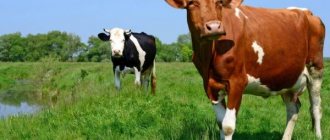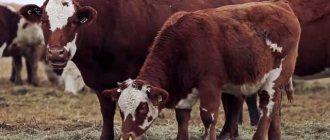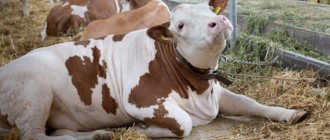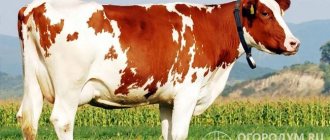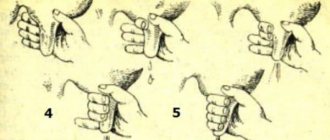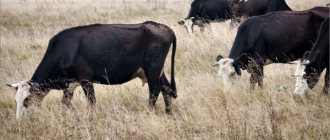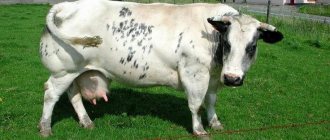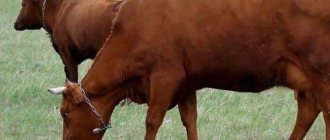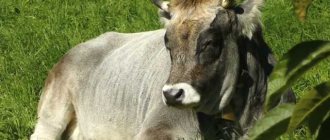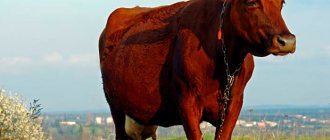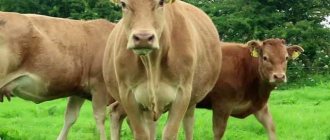To obtain stable milk from a cow, it is necessary to regularly renew her lactation, which requires the birth of a calf. Every owner should know exactly how a cow gives birth. Calving a cow, although a natural process, requires special attention to the animal and providing it with the right conditions. Complications can develop during pregnancy, immediately when the calf is born, and also later.
Newborn calf
What is calving?
Calving is when a cow gives birth. The process of giving birth to a calf begins with contractions, during which the cervix dilates. Next, attempts occur, during which the fetus is expelled from the uterus and comes out through the birth canal. The duration of the entire process depends on several factors:
- the presence of calving earlier - firstborns calve longer;
- the general health of the cow - a weakened animal gives birth longer than a completely healthy one, properly prepared for childbirth;
- fetal size – a large calf takes longer to emerge than a small one;
- number of calves.
Newborn calf with cow
Typically, a cow gives birth within a few hours. From the moment of pushing until the calf is born, about an hour passes. For first-time mothers, this lasts longer. We can say that the help of a veterinarian is required if the birth of a multiparous cow does not end within 10 hours, and that of a primiparous cow does not end within 12 hours. Some females have an individual feature in which the birth of offspring lasts longer, but only a veterinarian can detect this property when examining the animal. A veterinarian or an experienced breeder will determine exactly how a cow gives birth in a particular case - normally or too long.
Diet of pregnant cows
Starting from insemination, and throughout the cow’s pregnancy, the diet is selected with an eye to the stages of fetal formation. For the first 6 months, the animal must be given everything. Thus, the daily diet of a cow weighing up to 500 kg is at least 10-14 kg of grass hay. The amount of succulent feed reaches up to 20 kg.
In winter, they are given in assortment: silage, fodder potatoes, beets, carrots. In summer, the lion's share of succulent food comes from green grass in pastures. Concentrates are given separately, but not more than 2 kg. Plus there should always be table salt near the feeders, and chalk should be added to the feed.
Cattle cannot be milked continuously; in the last 3 months before giving birth, the body of a pregnant cow must be given rest. And about 70 days before calving, the animal is transferred to dry milk and milking is stopped altogether. This is called launching. By the appointed date of birth, the weight of the cow should be approximately 50 kg more than usual.
Stages of fetal development
As the fetus develops in the uterus, there is a significant monthly increase in its weight. By the time of birth, the calf weighs from 30 to 40 kg, and in large breeds it is not uncommon to weigh about 50 kg. In the first month after fertilization of the egg, the weight of the embryo is 1 g. At the end of the 2nd month of pregnancy, the weight of the embryo is already about 40 g. Further weight gain occurs more actively, and by the end of 3 months the fetus weighs 400 g, and at the end of 4 months 2.5 kg .
Fetal position before calving
When 2 calves are formed in the uterus, then at the time of birth their weight turns out to be slightly less than the standard weight when 1 fetus is formed. Such offspring are somewhat weaker than a single calf, but with proper care, two calves quickly reach normal sizes and do not lag behind in development.
How the fetus develops
Ketosis in cows (symptoms and treatment)
Once insemination occurs, the calf does not yet exist. The embryo gradually develops until it is born.
Here's how it happens:
- During the first month, various parts of the body begin to form: eyes, mouth. At this time, instead of skin, you can see the vascular network. The embryo weighs no more than one gram.
- The second month is the time when vital organs begin to be created. At the same time, the placenta begins to appear. The size and weight of the embryo increases. At the end of this month, the size can reach 8 cm, weight up to 20-30 g.
- During the third, fourth and fifth months, the testes are formed and horns begin to grow. When the fifth month ends, the embryo can already be called a calf.
- Over the next three months, active formation of internal organs occurs, and wool begins to grow.
Fetal development
285 days after conception, the calf is born.
How many days does a cow walk before calving?
The duration of gestation of a calf is influenced by a number of natural factors, due to which the process can be slightly lengthened or shortened. Such deviations are considered normal and do not require veterinarian intervention. A pathological change in the duration of pregnancy is also possible, when the birth of a calf occurs too early or with a strong delay, and then it is necessary to call a veterinarian to assess the situation and prescribe treatment if necessary.
Important! If there are disturbances during pregnancy and no treatment, the female may die.
Fine
Most often, calving occurs on day 285, but in most cases the appearance of a calf in the period from 240 to 311 is not considered a deviation. Early birth of offspring is observed in 6%, and no more than 10% of cows survive the term. It is impossible to say with absolute accuracy how many days a cow can walk.
Pregnant cow
Early birth of calves occurs if the fetus is large and the female is poorly cared for, causing her to suffer from vitamin deficiency and stress.
Attention! An animal can give birth earlier than standard time and during the first pregnancy.
How many can go
Cows can spend 26 days after the standard date of birth. If the 311th day of pregnancy has passed, and signs of labor are not observed, an urgent visit to the veterinarian is required, since this condition is pathological. If possible, an examination of the animal by a specialist to monitor the condition should be carried out already during walking at 10 days. The phenomenon is most often observed if the female has a hormonal imbalance.
Duration of pregnancy (pregnancy)
How long a cow's pregnancy lasts depends on a number of factors. The duration of pregnancy varies quite a lot. The average gestation period for a cow is 285 days. Deviations from this period may be large. Calving on day 311 or day 240 is not considered pathological. Cases when a cow takes too long are not common. The number of out-and-out heifers usually does not exceed 10%. Early birth is observed in 4-6%.
Hormonal disorders in the body and the slow formation of the calf due to the individual characteristics of the female can extend the gestation period.
Early calving occurs in cases where the cow has had poor, illiterate care, she experiences a slight deficiency of vitamins and minerals in the body, or suffers from stress. Large calves are also born earlier. When the fetus is small, birth is usually observed closer to the 300th day of gestation. Pregnancy longer than 311 days is pathological and requires veterinary intervention.
The average gestation period for a cow is 285 days.
If the birth of a calf occurs before the 140th day, it is not viable and we are talking about a miscarriage. Many factors can provoke it. Most often, miscarriage in a cow is caused by the following reasons:
- Poor content;
- Diseases of the reproductive system;
- Improper examination – especially rectal and manual;
- Too early ultrasound – before 1 month of pregnancy;
- Strong physical activity - driving a pregnant heifer to distant pastures.
A miscarriage can also occur in a cow in the event of sudden hormonal fluctuations. They can occur during rapid weather changes or when the animal is given a number of medications that are contraindicated in pregnant females (when the pregnancy has not yet been detected, due to the short period).
Pregnant cow
Knowing how long a cow carries, it is possible to calculate the approximate date of calving and qualitatively prepare for it. It is necessary to agree in advance with an experienced veterinarian so that, if necessary, he can urgently arrive and provide assistance to the animal.
Calving date determination
It is important for the cattle owner to know exactly the expected date of birth. This will make it possible to determine whether the calf is born early or normally, as well as how advanced the pregnancy is. How to find out when a cow will give birth is well known: it can be calculated in two ways. It is convenient to use any of them to determine the date. The choice depends only on the personal preference of the animal owner.
Using formula
Calculating the expected calving date using a formula is a fairly simple task. The formula looks like this: D=(H+11)(N-3). D – date of expected calving; H – the number when mating occurred; N – month in which the cow was covered. To understand how to determine the calving date using the formula, you need to consider an example of such a calculation. So, if the female was inseminated on September 9, then the result will be as follows: (9+11)(9-3)=20.06. Thus, the formula determines that the calf should be approximately born on June 20.
Using a launch and calving calendar
A special calendar is also maintained to determine the calving date. This is a cow calving chart that shows the month and day of insemination and calving. In such a calendar, each month usually has 5 dates (1,5,10,15,25). Also in it, breeders note the date of launch of the cow before calving, so as not to get lost and not miss this period. This cattle chart is especially useful if the farmer has several cows.
Cow pregnancy calendar
Cow calving schedule: how to calculate the appearance of calves
In order to properly prepare a cow for calving and start her dry on time, it is necessary to be able to predict the date of birth of the calf. Sexual maturity in females begins to appear at 7-8 months. The time of first mating or artificial insemination depends on the breed of cattle.
Loading …
Early maturing individuals quickly gain weight, their reproductive organs form early and hunting begins. They are ready for mating at 14-16 months. In late-ripening cows, weight can increase quickly, but the reproductive organs are formed closer to 2 years. Meat breeds are most often characterized by late ripening.
Females are taken to their first mating at 22 months
After mating, it is important to determine the female’s pregnancy. This is necessary to predict calving time
The first signs of pregnancy are not visible from the first months. The belly begins to increase only by the 5th month of pregnancy.
Pregnancy tests can be wrong. However, veterinarians do create pregnancy charts. They indicate the dates of mating and expected calving. How to schedule the calving of cows correctly? What needs to be taken into account?
How to calculate calving time?
In the first month after mating, specialists conduct rapid pregnancy tests, take blood and milk tests for the presence of human chorionic gonadotropin, which is a pregnancy hormone. The main sign of pregnancy is the beginning of heat in cows. If after mating the animal does not show any desire, behaves calmly, and avoids other individuals in the herd, then pregnancy is noted.
The time of mating or insemination is recorded in a log. Pregnancy in cattle lasts 285 days. The expected calving date is calculated using the calendar. She is placed in a certain column of the calving table. This is one way to calculate the time of birth of a calf. The date may deviate from calculations by 5 days. This is the norm.
More on the topic: Principles of treatment of serous mastitis in cows
Professionals have special tables. They already indicate the days of mating and calving. When carrying out mating, the veterinarian looks at the nearest day, which is indicated in the table. Using it, he can easily determine the time of appearance of the calf.
There are formulas for calving calving. D = (H+11)/(N-3), where
- D – date of birth of the calf;
- H – day of mating;
- N – number of the month in which mating occurred.
If mating occurred on May 1, then the calculation is performed: (1+11)/(5-3). D = 12/2, the calf will be born on February 12th. How to determine the day if insemination was carried out in March, because the month indicator will be “0”? carry out the calculation: (1+11)/(3-3) = 12/0. In this case, the calf can be expected on December 12th.
The name of the cow, its individual number are recorded in the log, the method of calculating calving is indicated, the date of insemination and forecast are recorded. Heifers may have a shorter gestation period. In an adult, the calf can stay in the womb for 5-7 days. This is not considered a pathology.
Running a Pregnant Cow
Starting a pregnant female is required so that she can gain strength before calving, and the volume of milk that will be produced after the calf is born is sufficient to feed it. Milking stops completely 2-3 weeks before the birth of the baby. The launch begins 2 months before the expected calving. Proper care and maintenance allow you to get healthy offspring and prevent the negative consequences of childbirth for the cow.
First of all, the cow's feeding diet changes. A few days before changing the milking regime, the following is excluded from the cow’s diet:
- green herbs;
- silage;
- concentrates;
- roots;
- succulent food.
The animal should only receive hay. The volume of water given to the cow also decreases. This allows you to reduce the amount of milk produced.
Proper starting of a cow before calving
To stop lactation, the number of milkings is reduced. They stop doing udder massage. Milking is gradually increased to once a day. Milking of beef cows is stopped completely when the volume of milk per day is no more than 1 liter, and milking of dairy cows is stopped when the volume is about 4 liters.
Important! You can't stop milking suddenly.
Sometimes it is necessary to use medication to start a cow. They are administered by injection. Only a veterinarian can determine the need for this method after examining the animal. This method is used when it is impossible to carry out a regular soft start.
Care and feeding
A pregnant cow requires a lot of attention. It must be kept warm, in a clean stall, where there is no dampness or draft. During the dry period, the animal needs daily hygiene - the skin should be brushed and the udder should be washed with warm water.
It is important to keep the litter clean. During pregnancy, the cow should walk a lot - if possible 2-3 times a day for an hour. This will avoid complications after childbirth such as udder swelling and other pathologies.
This will avoid complications after childbirth in the form of udder swelling and other pathologies.
The diet of a pregnant cow during the dry period should include:
- Good quality meadow hay.
- Root vegetables - carrots, potatoes, beets.
- Juicy food.
- Concentrates.
- Vitamin supplements (chalk, salt).
Important! The quality of the food supply must be strictly controlled - it is unacceptable to give the animal rotten hay, rotten vegetables, or sour food. You cannot give a cow cold water - sometimes this leads to miscarriage. The health of the future offspring, as well as the productivity of the animal, depends on the timeliness and correctness of the start of the cow.
The ideal time to start transitioning to dry cows is 2 months before calving. If the cow's milk yield is large, over 10 liters of milk per day, the start should be started earlier - 60-75 days before giving birth. If lactation does not stop despite dietary restrictions and changes in the milking schedule, it is necessary to use medications to start the cow
The health of the future offspring, as well as the productivity of the animal, depends on the timeliness and correctness of the start of the cow. The ideal time to start transitioning to dry cows is 2 months before calving. If the cow's milk yield is large, over 10 liters of milk per day, the start should be started earlier - 60-75 days before giving birth. If lactation does not stop, despite dietary restrictions and changes in the milking schedule, it is necessary to use medications to start the cow.
To properly organize the start-up, dry-off and calving periods, the farmer needs to keep a calendar that marks the cow's mating time. This will help you accurately calculate all the required dates.
If calving occurs earlier or later than the expected date, this depends on the characteristics of the cow and is considered acceptable. Normally, resolution of the burden occurs on the 285th day. Taking into account possible deviations, it is believed that calving can occur in the period of 265–300 days.
The animal's rest period from lactation must be at least 60 days. During this period, it is necessary to carefully monitor the diet and maintain the necessary conditions in the room. It should be illuminated, and the litter should be kept dry and updated daily.
Diet
During the period of starting a cow before calving, the artiodactyl should gain 60-65 kg in weight. Hay is suitable for feeding in the initial period to prevent overeating. She is also given a small amount of water at this time.
It is better to feed a cow at startup after the udder has dried out with the following products:
- chalk;
- bran;
- salt;
- special feed for prenatal cattle.
A month before the end of the launch period, the diet should include:
- feed mixtures for calving cattle;
- crushed corn;
- pressed sunflower seeds;
- processed beets.
The starting time is selected for each cow individually. It is determined by the following factors.
- Estimated calving date. There are formulas and tables to determine or calculate it.
- The age of the cow. The first heifer should be stopped milking gradually over a longer period.
- Milk productivity. Cows that produce a lot of milk are started more slowly.
Based on the above factors, the optimal start-up or dry period would be:
- for first-calf heifers and cows of high milk productivity - three months;
- for animals with average milk production - two or two and a half months.
The minimum duration of the dry period can be forty days.
This is achieved in the following way:
- changing your diet;
- stopping milking;
- decreasing (if milk production does not stop) the amount of water;
- reducing grazing time (if the start occurs in the summer).
Weekly readiness
A week before the expected calving, the cow needs constant monitoring, since it is impossible to accurately determine the day on which calving will occur. The owner must also fully equip the stall in which the cow will give birth and subsequently stay with the calf. It is advisable to carry out such preparation in advance, a month before the expected calving, so as not to encounter a problem if it happens early.
Feeding a week before giving birth requires special care. Nutrition needs to be balanced. Feeding with hay alone is stopped as soon as lactation stops. In order to understand how well a cow is eating, it is weighed. She should gain about 65 kg in the week before calving. If more than 75 kg of weight is gained, this means that the animal is overfed, which will negatively affect the process of giving birth to a calf. Underweight, when its gain is less than 50 kg, indicates a decreased appetite of the cow or inadequate quality of feed. Insufficient weight gain in a pregnant cow negatively affects the condition of the calf.
A week before the expected calving, you should wash the cow with warm water and treat its hooves with a solution of creolin with a strength of 2%. The animal must be kept as clean as possible.
Nutrition before calving
The period 2 weeks before calving requires a special approach. The cow should receive only high-quality cereal hay at this time. Everything else should be excluded, especially those foods that introduce excess fluid into the body. Three meals a day are maintained. A serving of food is approximately 10 kg, maybe a little less. It is recommended to water the cow during this period with clean water at a temperature of 8 to 10 degrees.
By the time of calving, the cow will gain up to 50 kg of weight - she looks plump, her udder is greatly enlarged. About a week before calving, secretions begin to be released from the udder.
How to prepare for childbirth
Preparing for the birth of a calf includes not only starting the cow, but also arranging the premises, purchasing the necessary materials and medicines. You also need to be able to immediately call a veterinarian if complications develop.
In the room in which the cow will give birth, the owner should have the following on hand:
- thick threads that can be used to tie the umbilical cord;
- scissors;
- iodine;
- diapers or waffle towels;
- laundry soap;
- latex gloves (disposable ones purchased at the pharmacy);
- warm boiled water (brought directly during calving).
It is advisable to find an assistant who will assist if necessary. Normally, an animal gives birth on its own without human help, but the development of complications cannot be ruled out, even in an individual that has already calved more than once.
Important! The scissors to be used must be sharp and disinfected.
Preparing the premises
The room in which the calf will be born must be warm and dry. The floors and walls of the barn must be washed with a chlorine solution. Then it is covered with clean, certainly soft hay, which must be changed daily. The cow should be in the prepared room already 5 days before the expected calving time. There should be no trash in the stall. The area is completely cleaned before the cow calves.
Cow with calf in equipped stall
The area for the cow and calf needs to be large enough so that they can feel comfortable in the future. The cow should give birth in a pre-prepared area as this greatly reduces the risk of calving complications.
Special diet
Before calving, the animal's feeding is changed. The volume of food is increased by 20%. 4 days before the expected calving, forage is excluded from the cow’s diet. The diet should consist only of high-quality hay and small amounts of green grass. The animal stops grazing a week before calving. How to feed a cow before calving will be determined by weighing, since overfeeding should not be allowed.
Term
You can find out the exact date of birth of the calf, which is calculated using a special formula. To the day on which fertilization occurred, you need to add 11, for example (8+11). Next, you need to divide by the number of the month of fertilization minus 3, for example (4-3). Ideally, the formula will be (8+11) / (4-3), that is, 17 must be divided by 1. The result will be 17. This means that calving will occur on this number 9 months after fertilization.
To avoid using formulas, you can use the calving calendar, where all insemination dates are marked. This is the most accurate table, which has 4 columns. The first and third indicate the month and date of insemination, but the second and fourth indicate the month and date of calving, respectively.
However, it will not be possible to accurately determine the calving period using such a schedule; the error will be within 10 days. Therefore, you need to either apply a formula to more accurately calculate how long the pregnancy will last, or watch how the cow feels.
How to recognize when calving is approaching
The owner's ability to correctly recognize the approach of calving allows him to avoid many problems associated with the unexpected onset of labor. The fact that the animal’s body has begun to prepare for the birth of a calf can be understood by external signs. The female's behavior clearly indicates that calving will occur soon. Preparing the cow for calving, such as washing her hindquarters with an antiseptic, begins when the first symptoms of labor appear.
External changes of the heifer
Before the birth of a baby, a cow undergoes certain changes that will be noticeable even to a novice breeder. The following signs indicate that calving is approaching:
- swelling of the genital organs – the genital slit looks swollen;
- discharge of milk from the nipples;
- udder swelling;
- opening of the genital slit and the release of mucus from it - the discharge of a cow before calving is a drainage plug.
When such external changes occur, monitoring the animal must be constant, since the birth of a calf will occur within the next few hours.
Attention! The first signs of calving in primiparous cows may not be sufficiently pronounced.
Animal behavior before calving
The behavior of the animal before calving also changes. Signs of calving in a cow appear when contractions begin. The cow becomes restless and constantly tries to lie on its side. This is an indicator that there are 3-4 hours left before calving itself. If the animal is grazing, then before calving it begins to look for a quiet place away from the rest of the herd. At this moment, it is necessary to take the cow to a previously prepared stall. Calving a cow and delivering a calf properly reduces the risk of complications.
How to determine launch and calving dates
A cow's sexual cycle lasts about three weeks. It includes the period of estrus, sexual heat and ovulation. If insemination occurs during ovulation, pregnancy occurs. On average, pregnancy in heifers lasts about 285 days. In rare cases, deviations are possible (from 270 to 300 days). It all depends on the breed of the animal, nutrition, age and sex of the future calf.
Having established the fact that a cow is pregnant, you immediately need to determine the start time. Since only the fact of insemination is known, and most modern breeds give birth at the 9th month of pregnancy, experts advise starting the breeding 7.5 months after mating.
Sometimes, regardless of pregnancy, a cow may self-start. This is caused by disease, improper milking or feeding.
During pregnancy, the animal must be well fed, and in the second half of the period, the volume of feed must be increased by 0.3 feed units. In the fifth month, the animal’s overall milk yield decreases and it is gradually necessary to transfer it to dry milk. If milk yield does not exceed 4 liters of milk, milking should be stopped immediately. For cows with high productivity, the number of milkings is reduced to two per day, then to one and stopped when the productivity is 1 liter at a time.
There are two ways to determine the launch date of a heifer. The first one is based on a simple formula:
D here is the approximate month and day of calving; H – date of mating month; N – serial number of the month of mating; 11 and 3 are constant numbers. Important: if mating occurred in the first two months of the year, “12” is added to the serial number of the month.
That is, if the cow died on May 15, then using the formula (15+11)/(5-3) it turns out to be 26/2. This means the calf will be born around February 26th.
There is a more convenient way - a calving calendar. Consists of two dates – mating and calving. It allows a deviation of 10 days, which is considered normal.
Approximately 70 days before the expected calving, the cow is started (transferred to dry land). Her body needs to rest before giving birth and replenish its supply of nutrients and minerals. Note that the fetus gains weight most intensively in the last third of pregnancy.
Depending on the productivity of the animal, the launch is carried out gradually, over several days. At this time, you cannot massage the udder and feed the heifer with green grass and concentrates. The time spent on pasture is slowly reduced. As a last resort, it is permissible to feed the cow hay. When the udder is no longer filled with milk, the diet can be returned to normal volume.
During the dry period in summer, farmers recommend keeping the heifer grazing for a significant part of the day, but without long hauls. In winter, pregnant animals are released into the pen for 3-4 hours.
By the time of calving, a normal heifer should gain approximately 50 kg in weight and be well-fed. To complete the pregnancy period, the cow should stop lactation, since simultaneously carrying a calf and producing milk negatively affects calving. When started correctly, the animal's udder becomes dry and drops significantly (until folds appear).
In accordance with the calendar, the cow must be closely monitored in the last two weeks before the expected due date. The udder increases significantly, and the belly is retracted. About 7 days before calving, the ligaments at the root of the tail and pelvis relax, become pliable, and a secretion similar to sugar syrup is milked from the udder. Within a day, colostrum flows to the udder nipples and the animal becomes restless.
Below is a table that determines calving time.
Calving
When calving proceeds without complications, minimal human intervention is necessary. Even a novice livestock breeder can cope with the task. In the same case, if complications are observed, the help of a veterinarian or an experienced farmer will be required.
The cow should be washed with warm water and laundry soap and its external genitalia should be wiped with sterile oil. You cannot make noise around a cow, as this will scare it. The owner should note the time of the onset of labor in order to be able to understand whether it is taking longer.
Calving process
First-time cows typically produce a calf lying down, while multiparous cows may stand. Contractions before the full opening of the cervix become significantly more frequent and turn into pushing. The amniotic sac appears from the genital slit, with a calf inside. The bubble may burst on its own or may need to be cut. The calf is born with its front legs first. After its complete release, the placenta leaves with a small amount of blood and mucus.
Advice! The afterbirth is inspected to make sure that it has come out completely.
The natural way
Natural calving occurs with virtually no human intervention. The owner will only need to accept the born calf, wiping it of mucus and clearing its nostrils. Also, to facilitate childbirth, if the amniotic sac does not rupture on its own, it is cut with scissors.
With human intervention
The owner's help is required only if complications develop during childbirth, the main ones of which are the following:
- weak attempts;
- the calf does not come out within 30 minutes after the membranes have ruptured or been opened;
- exit of the calf by the hind legs.
In all these situations, it is recommended to call a veterinarian. Experienced livestock breeders can quite often solve the problem themselves by pulling the calf out with an effort using a loop of rubberized rope draped over the legs. This kind of work is hard, and it is extremely rare for a woman to cope with it. If you are not sure to do everything successfully, then you need the help of a specialist.
Calving a cow with human assistance
Also, you cannot do without a veterinarian when a caesarean section on a cow is required (the birth of a calf through surgery). Surgery is necessary when the calf is too large to pass through the cow's birth canal, or the cervix does not open correctly. A specialist will recommend what to feed the cow after this.
Care during calving
When calving, the cow does not require special care. During contractions, the animal is washed from behind with warm soapy water and wiped. If a cow gives birth on her side, a pillow is made from hay and placed under her head. The first calving of a cow may require additional constant calming of the cow.
Advice! If the animal is very nervous, the owner can try to calm it down by brushing its sides with a stiff brush.
Birth of twins
Calving is the name given to a cow giving birth to either one calf or twins. This phenomenon is rare and accounts for no more than 4% of the total number of calvings. Twins are determined using ultrasound. If this procedure was not carried out, then it will be possible to find out exactly the number of calves only at calving.
Birth of twins
A cow that gives birth to two calves requires special control. If calving occurs without complications, both babies survive. In the uterus they are located so that one of them faces the vagina with its hind legs. Most often, calves are located on top of each other. To prevent the death of one of the fetuses, a person inserts his hand into the uterus and determines the position of the upper calf. When the first baby is born, the second should be carefully pushed into the uterine cavity. When pulling a calf is required, it is important not to confuse the legs and not grab one from one fetus and the other from another. Calves are born from twins usually with human participation.
Important! You should not try to deliver the baby faster by pulling the calf immediately when the legs appear, as this will most likely mutilate it and injure the cow.
Complications during calving
During the calving process, complications may develop that pose a threat to the calf and mother. The main complication during calving is its delay. The calf should be born within 30-60 minutes of the uterus fully opening. If this does not happen, the animal needs help.
Complications also include stopping the advancement of the fetus at any stage of labor. In this case, urgent assistance from a specialist is required.
Important! The owner of the cow should have the phone number of a veterinarian at hand, who can come at any time of the day if complications develop during calving
Childbirth
Help at the hotel
During the period of expected birth, the cow is not allowed to go for walks. The first aid kit is stocked
- iodine,
- potassium permanganate,
- Vaseline,
- ichthyol ointment,
- cotton wool, bandages, soap.
In case of a difficult birth, you need to stock up on a strong rope of two to three meters.
Signs of the beginning of calving.
- Anxiety;
- Trampling;
- Moos;
- If he doesn’t find a place, he will lie down and then get up;
- Looks at his stomach.
If these signs are detected, the labia, legs, and tail are washed and wiped dry with a warm solution of potassium permanganate (ratio 1 l / 1 g).
Childbirth usually occurs without complications. But it is advisable for the cow to lie down on her left side. This will make it easier for her. If all is well, it will be over within an hour.
You can make sure that the birth is proceeding normally by how, after the rupture of the amniotic sac, the front legs of the calf appear, and the head appears on them. This position of the fetus is considered correct. But it may turn out that the attempts are weak and the cow cannot give birth. Then she needs help. In this case, resort to using a rope. It is tied to the front legs of the calf and pulled synchronously with the cow's efforts. In more complex cases, you need to contact a veterinarian.
A newborn calf's mouth and nostrils are cleared of mucus. The site where the umbilical cord is cut is cauterized with iodine. The cow needs to lick the calf. She will use her rough tongue to clean the calf of mucus and at the same time massage it, which will help stimulate blood circulation.
Cow licks calf
After calving, the cow is given warm water in which salt is diluted in a ratio of 120 grams per bucket of water. After an hour and a half, she needs to be milked. The first jets are drained. They should not be given to a calf. The rest of the milked colostrum should be fed to the calf.
Within six hours, during normal labor, the placenta should pass. If he doesn't come out within a day, you need to contact a veterinarian.
During the first days after childbirth, pay special attention to the udder. Drink often to avoid mastitis. If all is well, then after a few days it can be sent out to pasture.
How to care for a calf
After birth, the calf is placed on a piece of clean burlap. Immediately wipe his nose, eyes and ears from mucus with sterile cotton wool, and then wipe him completely with a diaper or towel. The umbilical cord is broken off by hand at a distance of 10 cm from the abdomen. Blood is squeezed out from the remainder of the cord and it is treated with iodine. The baby is then carried on a burlap sack to the mother's head so she can lick it. You should not take a calf from a cow.
If the cow refuses to lick the baby, it is taken to a warm room to dry. In this case, you will most likely have to feed him from a nipple. If the calf is born very weak, it is kept separately from its mother.
Calf with mother
Calf nutrition
In the first week, the calf will feed on colostrum, which is produced by the mother. The first feeding should occur no later than 45 minutes after the baby is born. From the second week he is switched to mash, and from the 3rd week the gradual introduction of straw and fruit into the diet begins.
If the cow is a firstborn, then it can be aggressive towards the offspring. In such a situation, the calf will need to be kept separate from her, with colostrum milked for it. You will also have to separate the weak calf from the twins so that it can receive enough feed.
Advice! You can let the calf out to graze from the age of one month, when it is already able to eat grass on its own.
Breeding and care rules
The female cow repeats the sexual cycle cyclically. The schedule consists of the following parts:
- First comes the heat.
- Then - hunting.
- After this, the female ovulates.
In the case when mating occurs during the ovulation period, pregnancy occurs. On average, its duration is 285 days. In practice, slight deviations from this period are possible. It is considered normal when the pregnancy period lasts from 285 to 300 days.
Cow and calf
At a certain stage, a pregnant cow starts. From now on, she must follow special rules in order for the calving to be successful.
It is important to correctly determine the launch day. Moreover, one of the simplest ways to determine it is to count seven and a half months from the moment of conception.
It is necessary to monitor the fact of pregnancy of cattle. If she is expecting a calf, she is usually fed extra food from the very beginning of her pregnancy. When the fifth month begins, the cow's milk yield gradually decreases.
At the same time, you need to change the animal's diet. From now on, it is necessary to feed the cow only dry wood.
Note! It is necessary to control the amount of milk milked. As soon as it becomes less than four liters, milking must be stopped. It can be resumed only after the calf is born.
For those cows that are characterized by high milk production, the cessation of milking occurs a little differently. When milk yield per day is equal to four liters, the number of milkings is reduced to two per day. Then the amount of milk produced will continue to decrease. It is necessary to stop milking only after the milk yield drops to one liter.
Caring for a cow after calving
The animal's future health depends on proper care after calving. Mistakes often lead to the development of serious complications, which sometimes even result in death.
How to feed and what to drink
You should not overfeed a cow after calving. The portion of food should be 70% of the standard volume, which is returned to only a week after the birth of the offspring. The cow must be taken out to pasture so that she can eat herbs that will help her recover faster. Feeds are given at the same time.
An hour after calving, the cow should be given salted water to drink. It is prepared at the rate of 150 g of salt per 10 liters of water. This drink speeds up the animal’s recovery process.
When and how many times to milk a cow
The first milking, after the cow has calved, takes place 2 hours later. She will not produce milk, but colostrum, which is intended for the calf. Before milking, the rear part of the cow is massaged. The udder is washed with a weak solution of manganese. An udder massage is also required.
In the event that a cow suffers from mastitis that developed even before calving, she must be milked immediately after giving birth. The resulting colostrum is destroyed because it is contaminated and cannot be given to the calf. The first week you should milk up to 5 times a day, and the night break should not be more than 10 hours. Milking is carried out at the same time.
Cow milking after calving
How much milk does a first heifer give per day?
The volume of milk produced by a first-calf heifer depends on its breed. The indicator can range from 6 liters to 15 liters. Meat breeds have milk productivity significantly lower than dairy breeds.
When can you drink milk?
During the first week, the cow does not give milk, but colostrum, which is fed to the calf. It is acceptable for consumption, but it is much more important for the calf to receive it, and the colostrum should be left to it. After 7-10 days, the cow begins to produce milk that can be drunk by humans.
What to do after?
After calving, special attention should be paid to both the mother and the calf. After giving birth, the back of the cow, as well as its belly and genitals, should be soaped with laundry soap.
Then you need to rinse it off with warm water and wipe with a dry and clean towel. After 25 minutes, the cow should be given one bucket of water, and be sure to drink it warm. After 35 minutes the placenta should come out
After giving birth, the rear part of the cow, as well as its belly and genitals, should be soaped with laundry soap. Then you need to rinse it off with warm water and wipe with a dry and clean towel. After 25 minutes, the cow should be given one bucket of water, and be sure to drink it warm. After 35 minutes, the placenta should come out.
If the cow that will calve has health problems, then calving should only take place under the strict supervision of a doctor. In addition, the veterinarian must fill out a special calving calendar and give the cow a rest. Then you need to periodically monitor the condition of both the cow and the calf. In addition, to restore strength, you can give the cow an energy drink - this is a slightly salted aqueous solution.
As soon as the afterbirth comes out, it is necessary to change the bedding to fresh one, and also carry out the first milking. Before this, the udder must be thoroughly washed and wiped dry. The first to come is colostrum, which needs to be fed to the little calf. After this, it is imperative to milk the animal, especially for firstborns. This will allow the cow to produce a little more milk in the future.
When milking for the first time, it is very important not to damage the cow’s udder, so you must first massage not only the udder, but also the nipples. After milking it must be repeated
It is also necessary to rinse it and wipe it dry.
Don’t forget about the cow’s diet. Nutrition must be balanced and rich in vitamins.
First you need to give her silage and hay to start lactation. On the second day, you can add 1 kilogram of rice or bran to the diet, pre-soaked in water for a while. Further, their quantity can be increased to 2 kilograms. Already from the third day, you can try to introduce some root vegetables into the cow’s diet to increase lactation. After a week, the cow can be switched to complete food.
If an animal does not eat well after calving or has had a very difficult birth, then the feeding schedule must be coordinated with specialists. In addition, livestock farmers need to ensure that there is a sufficient amount of protein in the feed. Otherwise, the milk will be of poor quality.
A newborn calf must remove mucus from both its mouth and sinuses. This is done using a special pear. Next, you need to wipe his face and eyes with warm boiled water. Then you need to cut the umbilical cord 11 centimeters from the abdomen. After this, you need to squeeze out all the blood from it and treat the incision site with iodine.
If the calving went well and the cow has no complications, the calf can be brought to the cow. This is done so that she will lick it. After this, the baby’s health will improve significantly, and will also help the cow’s placenta come out faster.
Next, the calf must be transferred to a separate pen, where there must be appropriate bedding. Exactly one hour after calving, you can give him colostrum, since it is in the first hours that it is best absorbed by the body.
In 24 hours, the baby can approach the udder about 20 times. At the same time, he drinks in small portions. When drinking from a bucket, this can lead to bad consequences. After all, colostrum will fall on a scar that has not yet healed, which can cause it to rot. Therefore, if the calf is immediately separated from its mother, it is best to feed it from the nipple. You also need to make sure that the baby is gaining weight well, otherwise it is necessary to supplement him.
After 45-60 days after birth, calves need to receive special vaccinations. In addition to milk, the calf can gradually be fed with fresh hay, as well as beets or potatoes.
After a certain time, the volume of his food needs to be increased. Potatoes must be peeled.
Possible complications after calving
After calving, the cow may develop complications that will require mandatory treatment. It is necessary to involve a veterinarian. Few and only very experienced livestock breeders can independently restore the normal condition of a cow. Knowing exactly how to deliver a cow at home helps reduce the risk of complications.
The cow doesn't get up
A cow may not get up after calving for several reasons. To determine exactly what kind of disorder is occurring, you should try to lift the animal. If there is no paralysis and the cow stands up when forced but the hindquarters are drooping, there is likely damage to the sciatic nerve plexus at the sacrum.
The most severe complication that occurs after calving is paresis, in which the cow does not stand up, but for a short time becomes paralyzed and may lose consciousness. This complication is most likely in heavy animals of highly productive breeds. If treatment is started in a timely manner, the outcome for the cow is usually positive.
Postpartum paresis in a cow
The cow was not cleansed
A retained placenta is diagnosed if it does not come out within 8 hours. Within a day, it will begin to rot in the cow’s body, poisoning the entire body. If there is a delay, forced separation and removal of the placenta is necessary, which is carried out by a veterinarian. The condition of the cow will require special monitoring.
Udder swelling in a cow
Udder swelling after calving can occur for many reasons. The problem can be caused by infection of the mammary glands during the first milking, poor nutrition when there is too much fluid in the animal’s body, as well as injury. The specific cause is determined after examining the cow and assessing its diet. To solve the problem, you should definitely consult a veterinarian.
Cow vilifies
Diarrhea after calving often occurs due to improper feeding. It is not intense and does not threaten dehydration. In case of severe diarrhea, seeking veterinary help is required to determine the cause of the problem. Before the specialist arrives, the cow is given sweetened or salted water. You can also give a 30% glucose solution.
No milk
First-time mothers who calve often produce colostrum late. In this case, the calf milks the mother within 24 hours. With a pathological lack of milk, the following reasons may occur:
- severe stress before calving or during its process - causes a violation of the milk ejection reflex;
- mastitis;
- ketosis is a metabolic disorder in which the animal must be kept on a certain diet in order to obtain milk;
- improper feeding, which caused severe weakening of the body.
In cases where a cow does not begin to produce colostrum within 24 hours, consultation with a specialist is required to determine what causes the problem.
The cow has lost a lot of weight
Rapid weight loss after calving is not uncommon. The reasons for this complication are disruption of the stomach, when the digestion and absorption of food occurs incorrectly, or an exacerbation of a disease that was in a latent form and began to actively develop after childbirth.
It is also not uncommon for cows to develop acetonemia, which is a serious disease and is manifested by the accumulation of acetone in the body. The general behavior of a sick cow often resembles the clinical picture of rabies. Starting treatment from the moment the first signs of the disease appear allows you to save the individual. In severe cases, the animal dies due to exhaustion.
Hotel complications
This process weakens the cow. Sometimes the animal is unable to stand on its feet and begins to crawl. Problems can arise from vitamin deficiencies, damage to the sciatic nerves and inflammation.
To avoid complications, the condition of pregnant animals is monitored before birth.
- Farmers must carry out fortification.
- At the stage of dead wood, it is necessary to create reserves of useful substances in the female’s body. At this time, energy metabolism in pregnant cattle increases.
Feeding affects the development of the udder and the unborn baby.
The cows are fully provided with some of the important vitamins (A, D, E) and minerals. Poor nutrition leads to lethargy and exhaustion, affects productivity and reduces immunity.
In particular, in cattle, paresis begins from a lack of calcium. The disease can develop before calving, and signs are visible after. First-calf heifers are especially susceptible to the disease.
Signs of maternity paresis:
- no appetite;
- tired appearance, slowness or too much activity;
- temperature drop;
- shaky steps.
After childbirth, the disease can take two forms: mild and severe.
In the first, the neck area tenses, and the head leans towards the back of the body. The cow will rise to its feet.
In the second - prolapse of the tongue, diffuse vision, drying out of the cornea. The animal begins to have problems with the gastrointestinal tract, and paralysis of the limbs is observed.
Calving is considered a complication if the placenta does not come out within about 24 hours. The remaining membrane will lead to uterine diseases. Also, some animals eat the afterbirth, which can cause stomach problems. An experienced owner always monitors the situation.
Signs of retained placenta:
- part of the shell hangs down, becomes dirty and decomposes;
- a stench appears, inflammation begins in the uterus, blood poisoning occurs;
- the temperature rises, there is no appetite, the amount of milk decreases;
- tousled fur, the cow is hunched over.
Also, in females, the uterus may fall out. Main features:
- The animal seems to feel colic and begins to worry.
- A circular mass protrudes from the genital organs, sometimes emerging along with the bladder or rectum.
The uterus can be adjusted by both specialists and experienced farmers, but it is better not to do this yourself.
Consequences of prolapse: metritis, sepsis with peri- and parametritis, purulent endometritis. Thanks to timely assistance, diseases remain aside, and the cow will not become infertile.
Walks, good care, compliance with maintenance standards, vitamins, minerals - every farmer must take such preventive measures. Then the cow will give birth without problems, and she will respond with good productivity.
Tips and tricks
- It is recommended to draw up an individual calving calendar for a cow, taking into account the characteristics of a particular animal. This table is the most accurate.
- The firstborn should not be released to pasture if even slight signs of impending calving appear.
- The cow should not be stressed before calving.
- Daily inspection of the cow at the end of pregnancy will help determine that the cow is about to give birth.
- The time of the onset of contractions in a cow must be recorded for an accurate idea of the duration of the labor process.
- If a cow has multiple pregnancies, the animal's condition must be monitored by a veterinarian.
Signs of pregnancy in a cow by month
How to determine pregnancy at different stages:
- At the beginning of pregnancy, it is very difficult to determine this condition. The main signs: discharge from the genitals, absence of estrus. The last sign does not always indicate pregnancy, as it is also diagnosed in various diseases. In the first month, the uterus is grasped in the hand and the corpus luteum is palpated.
- In the second month, laboratory tests are performed to confirm pregnancy. The uterus moves towards the entrance to the pelvis. One horn. Which contains the amniotic sac, increases in size by 2 times.
- At 3 months, the horn increases to 15 cm. The floating fetus can be easily felt.
- At the 4th month, the uterus moves into the abdominal cavity, and the fetus and placenta (2 cm) can be identified. Blood vessels vibrate.
- At 5 months, most of the abdominal cavity is occupied by the cervix. The size of the placenta increases to 4 cm. The abdomen grows, the udder becomes larger.
- At the 6-7th month, the uterus descends into the peritoneum, making it difficult to feel the fetus.
- At 8 months it is possible to palpate parts of the calf’s body. The uterus is located in the pelvic area.
- By the 9th month, the lower wall of the abdomen and udder swells. The placenta increases to 8 cm. The fetus is in the pelvic cavity.
Be sure to read:
Feeding dairy cattle: daily allowances, diet, feed additives
How to launch
The launch should begin no later than 45 days before calving. The norm is 2 months, and for primiparous and highly productive cows the start begins in 70 days. But the animal still needs to be prepared for it.
Read also: Caesarean section in a cow
Gradually, over 5-7 days, succulent feed and concentrates are excluded from the diet. At this time, the cow is not even taken out to pasture. At the same time, the amount of fluid consumed is reduced. Udder massage should be stopped and the number of milkings reduced to 2.
By the time of launch, the udder sags and wrinkles appear on it. To stop the cow from milking, she is completely switched to hay.
In highly productive dairy breeds, you can stop milking and start a cow with a productivity of 4 liters per day. And for beef cattle, the milk norm at start-up is 1 liter. As soon as the cow was started, that is, transferred to a dry stand and stopped milking, the daily ration and assortment of regular feeds are returned within 3-4 days so that the animal gains weight.

